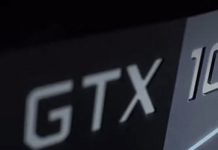This article has been just updated: January 15, 2024
When it comes to gaming, the graphics card is by far the most important component. The problem is that you can get a graphics card for as little as $100 or as much as $1,000. We don’t expect that your budget is infinite, which is why we’ve created this list of the top 7 best GPUs in 2024.
![]() When choosing a new graphics card, try to balance it with the rest of your computer. It makes no sense to spend $1,000 on a top-of-the-line graphics card if you have a budget CPU, slow hard drive, and only 8 GB of RAM. On the other hand, you don’t need a flagship CPU to drive a powerful graphics card—all you need is an overall balance of all components.
When choosing a new graphics card, try to balance it with the rest of your computer. It makes no sense to spend $1,000 on a top-of-the-line graphics card if you have a budget CPU, slow hard drive, and only 8 GB of RAM. On the other hand, you don’t need a flagship CPU to drive a powerful graphics card—all you need is an overall balance of all components.
If you play games in Full HD and don’t intend to move to 2K or 4K resolution anytime soon, just about any mid-range graphics card should satisfy your needs. For ultra-high-resolution gaming at 60 frames per second or more, only the best graphics cards on the market are fit for the job.
| CPU | Benchmark result | Price(according to Amazon) |
|---|---|---|
| 1. Nvidia GeForce RTX 2080 Ti | 16,988 | $999.99 |
| 2. AMD Radeon RX Vega 56 | 11,422 | $799.99 |
| 3. Nvidia GeForce GTX 1080 Ti | 14,129 | $945.00 |
| 4. AMD Radeon RX Vega 64 | 11,937 | $650.00 |
| 5. Nvidia GeForce GTX 1050 | 4,623 | $109.99 |
| 6. Nvidia GeForce RTX 2070 | 14,128 | $549.99 |
| 7. AMD Radeon RX 580 8GB | 8,418 | $324.00 |
1. Nvidia GeForce RTX 2080 Ti
Many people in the gaming industry believe that ray tracing, a rendering technique for generating an image by tracing the path of light as pixels in an image plane and simulating the effects of its encounters with virtual objects, is the future of computer graphics. If you want to experience ray tracing right now, you can buy the Nvidia GeForce RTX 2080 Ti and bring the power of real-time ray tracing to your games. The GPU is powerful enough to ensure smooth frames rates even when playing games in 4K resolution, and its reinvented design allows for maximum overclocking and cooler operation.
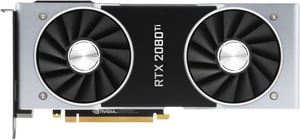
Benchmark result: 16,988
Pros: Efficient cooling design. Powerful performance. Support for cutting-edge rendering technologies.
Cons: Ray tracing is not yet widely supported. Expensive.
2. AMD Radeon RX Vega 56
The AMD Radeon RX Vega 56 is often seen as a Nvidia GeForce GTX 1070 contender, but the GPU is more than that. It provides a great entry-point into high-end gaming and makes tear-gaming possible thanks to its support for FreeSync technology, which is the brand name for an adaptive synchronization technology for LCD displays that support a dynamic refresh rate aimed at reducing tearing. FreeSync monitors are much more affordable than monitors with support for Nvidia’s G-Sync technology, and they greatly increase the overall value of the AMD Radeon RX Vega 56.
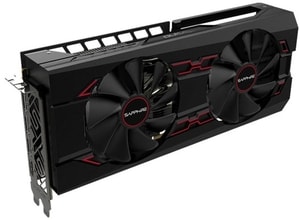
Benchmark result: 11,422
Pros: High-end gaming performance. Faster than the Nvidia GeForce GTX 1070. Support for FreeSync technology.
Cons: Inefficient design. Loud stock fan.
3. Nvidia GeForce GTX 1080 Ti
The GeForce GTX 1080 Ti is easily the ultimate gaming GPU from Nvidia. Featuring Nvidia’s groundbreaking Pascal architecture, the GPU delivers fantastic gaming performance while being surprisingly efficient. Compared with the previous generation of Nvidia GPUs, which were built on the Maxwell architecture, the GeForce GTX 1080 Ti can give you up to 3 times higher frame rates, making it suitable even for graphics-intensive VR gaming applications. It probably won’t surprise you to learn that its price reflects its performance, but high-end PC gaming has always been expensive.
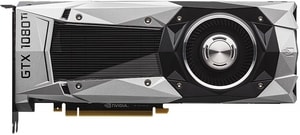
Benchmark result: 14,129
Pros: Improved design that ensures quiet operation and low temperatures. Impressive VR performance.
Cons: Not necessary unless you’re into 4K gaming.
4. AMD Radeon RX Vega 64
If you want the best Radeon graphics card AMD currently offers, look no further than the RX Vega 64. Powered by the Vega architecture, this uncompromising GPU is designed to deliver exhilarating performance in the newest DirectX 12 and Vulkan games, and it does so without much effort. When it was first released, the AMD Radeon RX Vega 64 was priced rather high, so it was difficult to recommend it over more efficient graphics cards from Nvidia. But its price has dropped significantly, and we think that buying is a smart decision.
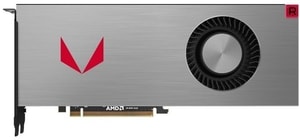
Benchmark result:11,937
Pros: Powerful performance at an affordable price. Great for Vulkan games.
Cons: Noisier than competing graphics cards.
5. Nvidia GeForce GTX 1050
Console gamers like to say that PC gaming is too expensive. Although PC gaming can be expensive, it certainly doesn’t have to be. You can buy an affordable GPU such as the Nvidia GeForce GTX 1050 and comfortably play all popular eSports games such as Fortnite or League of Legends or Overwatch in Full HD and at medium or higher details. The Nvidia GeForce GTX 1050 is extremely compact, so you can fit inside a MicroATX case to save space under your desk.
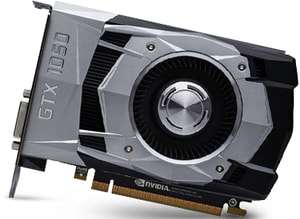
Benchmark result: 4,623
Pros: Small form factor. Tiny power consumption. Everything you need to play popular eSports games such as Fortnite.
Cons: Limited amount of video memory. Not great for more demanding games.
6. Nvidia GeForce RTX 2070
If you want to enjoy all the technology that makes the GeForce RTX 2080 Ti such a wonderful GPU but are not willing to pay what Nvidia is asking for it, the GeForce RTX 2070 is your next best option. It’s powered by the same Turing GPU architecture and the all-new RTX platform as its more expensive sibling, but it costs only half the price of the GeForce RTX 2080 Ti. Perhaps because the RTX 2070 is so much more affordable than the GeForce RTX 2080 Ti, it doesn’t support pairing multiple GPUs through SLI. So, if you would like to do a multi-GPU setup, you have to pay more for Nvidia’s high-end GPU.
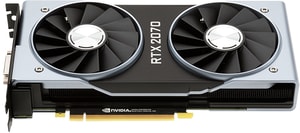
Benchmark result: 14,128
Pros: Great value. Low energy consumption. Relatively compact design.
Cons: Doesn’t support SLI.
7. AMD Radeon RX 580 8GB
The AMD Radeon RX 580 8GB is very comfortable with AAA games at Full HD, and it does surprisingly great even at 2K. Instead of being a brand-new card, think of it as a successful refinement of the RX 480, which was released in 2016 and instantly became a huge mid-range success. Just like its predecessor, the RX 580 supports FreeSync technology for tear-free gaming, and it’s not afraid to take on VR experiences.
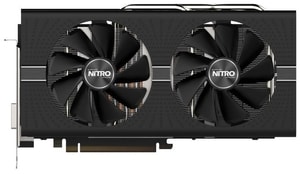
Benchmark result: 8,418
Pros: Decent 2K and great Full HD performance. Support for FreeSync. Great value for money.
Cons: Large and power-hungry.
Conclusion
In 2024, the GPU market is as healthy as ever. Regardless of what your performance requirements are, you shouldn’t have a problem finding a suitable GPU that can meet them with flying colors and fit into your budget at the same time.
FAQ
What were the top-performing GPUs in 2024?
The top-performing GPUs in 2024 included models like the NVIDIA GeForce RTX 2080 Ti, NVIDIA GeForce RTX 2080, NVIDIA GeForce GTX 1080 Ti, AMD Radeon RX Vega 64, NVIDIA GeForce GTX 1070 Ti, AMD Radeon RX 580, and NVIDIA GeForce GTX 1060.
How did the NVIDIA GeForce RTX 2080 Ti stand out from the rest?
The NVIDIA GeForce RTX 2080 Ti stood out with its groundbreaking Ray Tracing technology and Tensor Cores for deep learning, offering superior performance and advanced features for gaming and professional applications. It delivered exceptional benchmarks that significantly outpaced its competitors.
Can you provide benchmarks for the NVIDIA GeForce GTX 1080 Ti?
Benchmarks for the NVIDIA GeForce GTX 1080 Ti showcased its high performance in gaming at 4K resolution. It typically ran games comfortably above 60 FPS on ultra settings, making it one of the best GPUs for gaming enthusiasts in 2024.
What made the AMD Radeon RX Vega 64 unique compared to NVIDIA GPUs?
The AMD Radeon RX Vega 64 offered unique features such as the HBM2 (High Bandwidth Memory) and was AMD’s top-tier GPU in the high-end market, competing closely with NVIDIA’s offerings by providing solid performance in gaming and professional tasks.
Was the NVIDIA GeForce RTX 2080 good for 4K gaming?
Yes, the NVIDIA GeForce RTX 2080 was capable of 4K gaming, though for more demanding games, it might not maintain a consistent 60 FPS on the highest settings. It bridged the gap between the 1080 Ti and the 2080 Ti in performance and price.
What was the target audience for the NVIDIA GeForce GTX 1070 Ti?
The NVIDIA GeForce GTX 1070 Ti targeted gamers looking for excellent performance at 1440p resolution, without the price tag of the higher-end 1080 Ti. It offered a sweet spot in terms of price-to-performance ratio.
Was the AMD Radeon RX 580 a good option for budget-conscious gamers?
Absolutely, the AMD Radeon RX 580 was a favorite among budget-conscious gamers. It delivered solid performance for 1080p gaming with the ability to handle most games at high settings, making it a great value-for-money choice.
How did the NVIDIA GeForce GTX 1060 perform in 2024 gaming benchmarks?
The NVIDIA GeForce GTX 1060 was a popular mid-range card that performed well in the majority of 1080p games, even on high settings, and was considered a go-to for budget gaming builds.
What type of cooling solutions was common in the top GPUs of 2024?
The top GPUs of 2024 commonly employed advanced air and liquid cooling solutions to maintain optimal temperatures during intense gaming sessions or heavy workloads, with many models featuring custom cooler designs from various manufacturers.
Were there any significant architectural improvements in 2024 GPUs?
Yes, 2024 saw significant architectural improvements, especially from NVIDIA with their Turing architecture that introduced real-time Ray Tracing and AI-driven enhancements, changing the landscape of gaming graphics.
Could you SLI or Crossfire the best GPUs of 2024 for better performance?
While it was possible to SLI or Crossfire some of the best GPUs of 2024, the support for multi-GPU configurations was dwindling, with game developers and manufacturers focusing more on single GPU performance optimization.
What resolutions and frame rates could gamers expect from the top GPUs of 2024?
With the top GPUs of 2024, gamers could expect to run most games at 1440p and 4K resolutions, with frame rates ranging from 60 FPS to over 144 FPS on 1080p, depending on the game and settings.
Did the best GPUs of 2024 support VR gaming?
Yes, the best GPUs of 2024, such as the NVIDIA GeForce RTX series and the higher-tier AMD Radeon cards, offered strong support for VR gaming, providing the necessary performance to handle VR’s intense graphical demands.
What was the range of memory sizes available in 2024’s top GPUs?
In 2024, top GPUs came with a range of memory sizes, typically from 6 GB in a model like the GTX 1060 up to 11 GB in the RTX 2080 Ti, catering to different performance needs and price points.
How energy-efficient were the best GPUs of 2024?
The best GPUs of 2024 like the NVIDIA RTX series were designed with energy efficiency in mind, employing advanced manufacturing processes that resulted in higher performance per watt compared to previous generations.
Were any of the 2024 GPUs particularly good for cryptocurrency mining?
During that period, GPUs such as the AMD Radeon RX 580 and NVIDIA GTX 1070 Ti were popular among cryptocurrency miners due to their excellent hash rates and relatively lower power consumption compared to their mining performance.
Did the top GPUs of 2024 require external power connectors?
Yes, most of the top GPUs of 2024 required external power connectors, mainly 8-pin or 6-pin PCIe power connectors, depending on the card’s power consumption and performance level.
What was the price range for the top GPUs in 2024?
The price range for the top GPUs in 2024 varied widely, from around $250 for budget-friendly options like the RX 580 to $1,200 or more for high-end models like the RTX 2080 Ti, reflecting the performance tier and features.
For further details on GPU releases and technological advancements, where can consumers find more information?
Were there any notable driver updates in 2024 that improved GPU performance?
In 2024, there were several driver updates from both NVIDIA and AMD that brought performance improvements, bug fixes, and new features to their GPUs, which is a common practice to ensure GPUs perform optimally throughout their lifespan.




